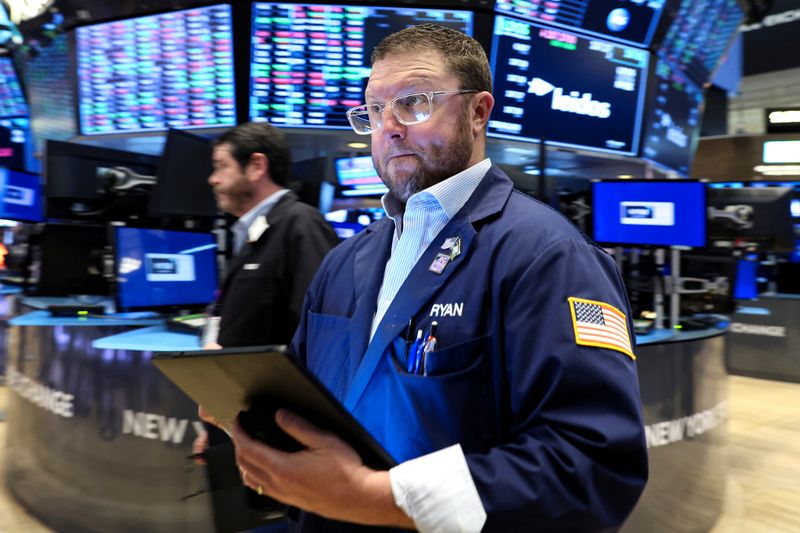
© Reuters. FILE PHOTO: Traders work on the floor of the New York Stock Exchange (NYSE) in New York City, U.S., March 30, 2022. REUTERS/Brendan McDermid
By Saqib Iqbal Ahmed
NEW YORK (Reuters) – Traders are pointing to a massive quarterly options trade on Thursday they said was from a JPMorgan (NYSE:) fund as one reason why the stock market took a nosedive late in the day, as options flows linked to the trade exacerbated market weakness.
The fell 1.2% in the last hour of trading on Thursday, marking the largest hourly drop for the index in more than three weeks. It finished the day down 1.56%, with some attributing part of the weakness to the large options trade that went down earlier in the day.
“I think that trade exacerbated volatility,” said Kochuba, founder of analytic service SpotGamma, noting that this was out of the ordinary since the quarterly hedging activity typically does not move markets much.
The way the trade is structured means when the market starts to fall, options dealers – typically big financial institutions who facilitate trading but seek to remain market neutral – would have been forced to sell an increasing number of stock futures, thereby aggravating the selloff, SpotGamma’s Kochuba said.
Markets have had a rollercoaster quarter due to Russia’s invasion of Ukraine, volatile commodities prices and the U.S. Federal Reserve starting to hike interest rates. It was unclear what caused the initial late-afternoon market weakness on Thursday that triggered the cascade of stock futures selling.
The trade, which took place shortly before 11:00 am, was a large collar options trade, involving the sale of about 44,000 June calls and the purchase of an identical number of June put spreads, that would pay up if the S&P 500 were to decline more than 5% from its current level. A collar is an options hedging strategy involving a combination of puts and calls.
The trade also involved the sale of about 24,800 calls linked to the 4,300 level on the S&P 500, set to expire at the end of Thursday’s session, as a way to guard against any sharp moves in the market during the trading session.
Traders pointed to the $19 billion JPMorgan Hedged Equity Fund as being behind the moves. The fund, which holds a basket of S&P 500 stocks along with options on the benchmark index and resets hedges once a quarter. As the fund is so large, traders know and anticipate its patterns.
Kochuba said that based on past trading patterns and details of investment strategies laid out in the fund’s prospectus, the trade was initiated by the JPMorgan Hedged Equity Fund.
Joe Tigay, portfolio manager at Equity Armor Investments, also said the trades had the hallmark of the JPMorgan fund’s hedging program.
Asked about the trades, Kristen Chambers, a spokesperson for JP Morgan Asset Management, confirmed that the fund has a scheduled quarterly hedging program but did not confirm the exact details of the trade.
Systematic traders, often hedge funds, take a rules-based approach in their investments and are often driven by fixed quarterly schedules rather than strong investment themes.
As such, other investors don’t try to glean signals from their choices of options strike prices and expiration dates, as they would with a trade by a discretionary investor.
“This is a systematic trade that we see at the end of every quarter,” Chris Murphy, co-head of derivatives strategy at Susquehanna International Group, said.
Thursday’s trade, worth about $20 billion in notional terms – based on the index level – replaces a similar position opened at the end of last quarter, according to Trade Alert data.


Be the first to comment